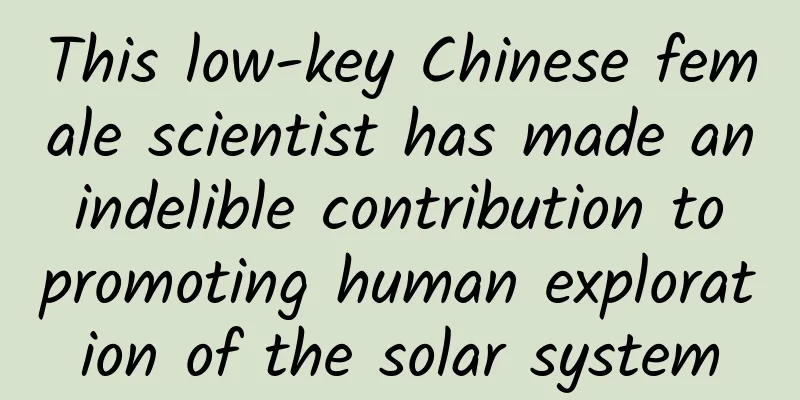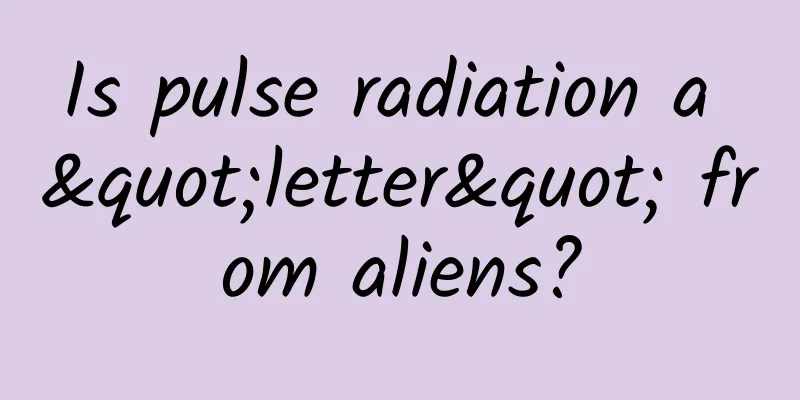This low-key Chinese female scientist has made an indelible contribution to promoting human exploration of the solar system

|
She showed extraordinary talent in orbital dynamics: the series of work she led or participated in promoted the process of human exploration of Mercury, comets, asteroids and other planets in the solar system. Her orbital design laid the foundation for the success of the Mercury orbiter "Messenger", and made a great contribution to the breakthrough of human exploration of Mercury orbiter; the orbits she designed for the comet sampler and the asteroid probe "Stardust" helped humans to sample cometary materials and return them to Earth for the first time. She is a low-key scientist, and there is not much public information about her, but she will not be forgotten. Written by | Wang Shanqin In the course of human exploration of the solar system, using probes to observe target celestial bodies at close range or even at zero distance is the most effective, but also the most difficult way. So far, humans have explored various celestial bodies in the solar system in this way. An important process of launching a probe to a target celestial body is orbital operation: from the Earth to the target celestial body, the distance often ranges from hundreds of thousands of kilometers to billions of kilometers. In this long process, how to make the probe use as little propellant as possible is a core issue: people always hope to make the total mass of the probe as small as possible, and have as much propellant as possible to perform operations such as orbit change when arriving at the target celestial body. Therefore, orbital dynamics experts who design the most optimized orbit for the probe become crucial members of the probe project. Among all the outstanding orbital dynamics experts, there is a Chinese female scientist who has made outstanding contributions to human exploration of celestial bodies such as Mercury, comets, and asteroids. Without her, the process of launching a Mercury orbiter might have been delayed for several years. She is Yan Liu Zhenwan, an orbital dynamics expert at NASA. (This article will refer to her as "Liu Zhenwan" below. If Yan is her husband's surname, then this is her original name; if Yan is the surname of one of her parents, then this is her given name.) [Note 1] From Taipei First Girls' High School to MIT In 1944, Liu Zhenwan was admitted to Taiwan’s most famous girls’ school, Taipei First State Girls’ High School (abbreviated as “Taipei First Girls’ High School”). Liu Zhenwan completed her junior high and high school education here, and then entered National Taiwan University. After graduating from university, she went to the Massachusetts Institute of Technology to pursue a doctorate in physics, and received her doctorate in 1964, with research in high-energy nuclear physics. Liu Zhenwan is very low-key and there is very little information about her. Apart from the schools she attended and her scientific contributions, people don’t know much about her. The following is her few non-academic personal information: she lives in California and has two sons with her husband. She likes to play the piano, hike and paint. [1] In 1972 [Note 2] , Liu Zhenwan joined NASA’s Jet Propulsion Laboratory (JPL) as an orbital dynamics expert. While working at JPL, her research areas were not limited to orbital dynamics, but involved multiple directions: Jupiter, aerospace computing, aerospace instruments, artificial satellites, avionics, planetary atmospheres, planetary magnetism, planetary satellites, satellite navigation, solar wind, spacecraft and other fields. [2] Work related to orbital dynamics requires superb celestial mechanics and mathematical abilities, which are obviously very different from the high-energy nuclear physics that he focused on during his doctoral studies. As a scholar with a background in high-energy nuclear physics, it is very rare for him to achieve outstanding achievements in orbital dynamics. After joining JPL, Liu Zhenwan participated in the design of the flight trajectory of probes such as Voyager. What really made her "a legend" was the major breakthrough in the design of Mercury exploration orbits. Mercury Orbiter Conundrum Mercury is the closest planet to the sun among the eight planets in the solar system. However, Mercury has been a little-known target for exploration in the space age. It was not until the late 1960s that NASA began to seriously prepare to launch a Mercury probe. In 1970, Giuseppe Colombo (1920-1984), a scientist, mathematician and engineer from the University of Padua in Italy, was invited to attend a meeting at JPL and announced an orbital plan he had designed not long ago: after the probe leaves the earth, it will use the gravity of Venus to increase its speed and lower its perihelion to the perihelion of Mercury; after flying past Mercury, the probe will orbit the sun once during the time Mercury orbits the sun twice. In this way, the probe can fly past Mercury many times and observe the various properties of Mercury. JPL experts verified the feasibility of this orbit through calculations. On November 3, 1973, the Mariner 10 probe was launched, flew past Venus on February 5, 1974, and then successfully flew past Mercury three times on March 29, September 21, and March 16, 1975, becoming the first probe in history to explore Mercury and obtaining images of 40%-45% of the surface of Mercury. Spare parts for Mariner 10. Image credit: Smithsonian Institution Inspired by the success of Mariner 10, astronomers and orbital dynamics experts began planning in 1974 to launch an orbiter capable of orbiting Mercury, thereby allowing continuous and in-depth observations of Mercury's various properties. However, it is very difficult to make a probe orbit Mercury. This is because the gravitational pull of the sun near Mercury is too strong. When the probe approaches Mercury, the strong gravitational pull of the sun on the probe will accelerate the probe to a high speed. In order to make the probe orbit Mercury, the high-speed probe must be slowed down in time, and then find a suitable direction to insert into Mercury's orbit and revolve around Mercury. In contrast, Mariner 10, which flew past Mercury three times, orbited the Sun instead of Mercury after the first flyby, so the problem of deceleration of high-speed probes caused by strong gravity was not as acute. In addition, Mercury's own mass is the lowest among the eight planets in the solar system - only 1/18 of the Earth's mass and half of Mars' mass; therefore, Mercury's ability to capture a probe is even lower, which further increases the difficulty of slowing down the probe into orbit. There are two ways to slow down a probe. The first is to have the probe periodically enter Mercury's atmosphere and rely on the drag of Mercury's atmosphere to continuously slow it down. The second is to carry a large amount of propellant and ignite it to slow down. Mercury's atmosphere is very thin, so the first method is not feasible. If the second method is used, the mass of the propellant that the probe needs to carry is too large, and the mass and volume of the probe itself are too large. In order to launch it near Mercury, a heavy-duty launch vehicle with particularly large thrust is required, which is too expensive. Thus, the dream of launching a Mercury orbiter was shelved for 10 years. Six flybys of Mercury In 1985, Liu Zhenwan selected different launch time windows (the time period most suitable for launching a probe) and orbital data, and used calculations to demonstrate the feasibility of launching a Mercury orbiter. Liu Zhenwan found [3] that if the probe flew past Venus and Mercury multiple times during its flight, combined with the probe's maneuvers and attitude control, it would be possible to use relatively little propellant to reduce the relative speed between the probe and Mercury, and then enter Mercury's orbit. Since the mass of the required propellant is greatly reduced, the probe can be launched using the relatively cheap Delta II rocket. [4] This solution solves the previous dilemma of "saving money while getting into orbit". After that, aerospace experts and astronomers from the United States, Europe and Japan proposed various specific plans, but they were rejected for various reasons. In the end, MESSENGER[Note 3] was selected into NASA's Discovery Program series in July 1999 because it met NASA's requirements of "faster, better, cheaper" at the time. Artist's impression of the MESSENGER spacecraft exploring Mercury. Image credit: NASA After MESSENGER was selected, Liu Zhenwan designed eight new orbits for it in a paper published in 2001.[5] The seventh orbit was planned as follows: MESSENGER was launched on May 9, 2004, and then flew past Venus three times (VGA1, VGA2, and VGA3), and finally flew past Mercury once (MGA1), and finally entered orbit around Mercury on July 2, 2009. The seventh option in the new orbit of the Mercury orbiter designed by Liu Zhenwan in 2001. The three dotted circles from the outside to the inside represent the orbits of Earth, Venus, and Mercury respectively. The date is marked as "month/day/year" (the same below). Image source: Reference [5] NASA adopted this plan, but postponed the launch time a few days later, setting it within the 12-day launch window starting on May 11, 2004. However, in order to further test the probe, NASA postponed the launch time to the 15-day launch window starting on July 30, 2004. Therefore, the flight trajectory was redesigned. According to the new trajectory, MESSENGER will fly past the Earth once, Venus twice, and Mercury three times, and enter orbit on March 18, 2011. This is two years later than the original planned arrival time. The difference of two years also shows the wisdom of the trajectory designed by Liu Zhenwan. On August 3, 2004, MESSENGER was launched on a Delta II rocket. Together with the propellant it carried, the total mass of the probe was only 1,108 kilograms. The MESSENGER spacecraft was launched aboard a Delta II rocket. Image credit: NASA Since then, MESSENGER has flown past Earth, Venus, Venus, Mercury, Mercury, and Mercury on August 2, 2005, October 24, 2006, June 5, 2007, January 14, 2008, October 6, 2008, and September 29, 2009. In addition to these six flybys, MESSENGER also performed five deep space maneuvers (DSM), which involved firing its boosters to perform orbital corrections. MESSENGER's orbit, six flybys and five deep space maneuvers (DSM) are also marked. MOI stands for Mercury Orbit Insertion. Image credit: NASA On March 18, 2011, MESSENGER entered Mercury's orbit and became the first orbiter of Mercury, that is, the first artificial satellite of Mercury. Since Mercury has no natural satellite, MESSENGER is also the first satellite of Mercury. From its launch to its orbit, MESSENGER flew for 6 years, 7 months and 16 days, and flew a distance of 7.9 billion kilometers. Although it takes a long time, such an orbit saves a lot of propellant used for the final deceleration into orbit. Based on Liu Zhenwan's work, humans finally realized their desire to launch an orbiter to Mercury at a very low cost - it cost no more than 450 million US dollars. Compared with other planetary probes that cost tens of billions or even hundreds of billions of dollars, this can be considered very cheap. From April 4, 2011 to April 30, 2015, MESSENGER has been carrying out observation missions and has achieved a large number of results, which has greatly deepened mankind's understanding of Mercury and still represents the highest level of human exploration of Mercury. One of the images of Mercury taken by MESSENGER at an altitude of 27,000 kilometers during its flyby on October 6, 2008. Image credit: NASA/Johns Hopkins University Applied Physics Laboratory/Arizona State University/Carnegie Institution of Washington April Madden, in All about Space, quotes astronomer Paul Byrne: "In 1985, Yen Liu Zhenwan at the Jet Propulsion Laboratory figured out the trajectory you had to follow to orbit Mercury. Before that, we had no idea how to get a spacecraft around Mercury."[6] Stardust orbit designer Another important task of Liu Zhenwan is to design the trajectory for the Stardust sampling probe, which aims to directly collect material from comets and bring it back to Earth. Artist's impression of Stardust collecting cometary material. Image credit: NASA Stardust was launched on a Delta II rocket on February 7, 1999. At launch, Stardust had a total mass of 385 kg, of which the mass of propellant was about 80 kg. Stardust launches aboard a Delta II rocket. Image credit: NASA/JPL The following is a simplified diagram of a portion of the Stardust orbit designed by Liu Zhenwan. The yellow dot in the diagram is the sun; the smallest gray ellipse is the orbit of the earth; the largest gray ellipse is the orbit of Comet Wild 2. The orbit of the Stardust comet sampling probe designed by Liu Zhenwan. Image source: NASA - Stardust Launch Press Kit Several important nodes of Stardust's orbit are (refer to the figure above): 1. Launched on February 7, 1999 (indicated by the red square, mistakenly marked as the 6th in the figure); 2. Orbiting the red orbit, collecting interstellar dust from March to May 2000; 3. Flying past the Earth on January 15, 2001 (indicated by the blue square, most of which is covered by the green square); 4. Flying past the asteroid 5535 Anne Frank (not marked in the figure) on November 2, 2002; 5. Orbiting along the blue orbit, encountering Comet Wild-2 on January 2, 2004 (indicated by the yellow square), collecting material from the latter; 6. Continuing to orbit along the blue orbit, collecting interstellar dust again from July to December 2002; 7. Returning to the Earth (indicated by the green square) on January 15, 2006, the probe dropped the sample return capsule into the Earth's atmosphere and left. After separating from the sample return capsule, the Stardust probe continued to orbit the Sun, and flew past Comet Tempel 1 (9P/Tempel) on February 15, 2011. Since Stardust continued to operate until 2011, its actual orbit is more complicated than the orbit shown above (until 2006). Stardust captured this image of Comet Tempel 1 on February 14, 2011. Image credit: NASA/JPL-Caltech/Cornell On March 24, 2011, Stardust burned up its remaining propellant, shut down communications, and successfully completed its mission. It still had some propellant left at the end, thanks to Liu Zhenwan, who designed the orbit. Artist's impression of Stardust burning its remaining propellant at the end of its mission. Image credit: NASA/JPL Remember to thank her During her more than 40 years at JPL, Liu Zhenwan not only designed the optimal orbits for the MESSENGER and STARDUCT probes, participated in the orbit design for the Voyager probes, but also participated in the orbit design for the Cassini probes that explored the Saturn system, the Magellan probes that explored Venus, and the Galileo probes that explored the Jupiter system. She used her talents to promote the process of human exploration of various celestial bodies in the solar system. Artistic imagination of celestial bodies in the solar system (eight planets, asteroids, comets). Image source: NASA/JPL Two months after the successful launch of Stardust, NASA announced in April 1999 that the asteroid formerly numbered "4606 PL" would be renamed "9249 Yen". [1] This was a recognition of Liu Zhenwan's contribution to the design of the Stardust orbit, as well as her contribution to the sophisticated design of various probe orbits over the past 30 years. On April 9, 1999, NASA's JPL official website released a news article titled "Asteroid Named for Stardust Comet Mission Designer". Image source: Screenshot of reference [1] On October 20, 2018, the new generation Mercury orbiter BepiColombo (Colombo's nickname is Bepi), named in honor of Giuseppe Colombo, was launched. Similar to MESSENGER, Colombo will fly past the Earth once, Venus twice, and Mercury six times in more than seven years, and then arrive at Mercury in December 2025 and orbit Mercury, becoming the third Mercury probe and the second Mercury orbiter in human history. Liu Zhenwan Image source: Reference [2] Since the orbital pattern of the Colombo closely replicates the orbital pattern of the MESSENGER and also adopts the scheme proposed by Liu Zhenwan in 1985, American space historian Dwayne Day said: "When it (BepiColombo) reaches Mercury, I hope that people will express a little gratitude to Liu Zhenwan in addition to thanking Giuseppe Colombo. She did the calculation 40 years ago and inspired people to think about Mercury's orbit." [Note 4] Notes [Note 1] Yen Liu Zhenwan's full English name is Chen-Wan Liu Yen, which she usually shortened to Chen-wan L. Yen or CWL Yen; some sources omit Liu and write it as Chen-Wan Yen or CL Yen. In literature, the surname is often placed before the given name, so there are various other corresponding spellings, such as Yen, CL. [Note 2] Deduced from the reference [1] that states “Since joining JPL 27 years ago” and the reported date (1999). [Note 3] MESSENGER is the abbreviation for Mercury Surface, Space Environment, Geochemistry, and Ranging. [Note 4] The original text is: "When it reaches Mercury, hopefully, in addition to Giuseppe Colombo, some people will give a little thanks to Chen-Wan Yen, who 40 years earlier made the calculations that inspired people to think about orbiting Mercury." For the full text, see Reference [4]. References [1] https://www.jpl.nasa.gov/news/asteroid-named-for-stardust-comet-mission-designer [2] https://ieeexplore.ieee.org/author/37088722238 [3] Yen, CL, “Ballistic Mercury Orbiter Mission via Venus and Mercury Gravity Assists,” AAS/AIAA Astrodynamics Specialist Conference, Paper AAS 85-346, Vail, CO, August 12-15, 1985. [4] https://www.thespacereview.com/article/4349/1 [5] Yen, CL, “New Trajectory Options for Ballistic Mercury Orbiter Mission,” AAS/AIAA Space Flight Mechanics Meeting, Paper AAS 01-158, Santa Barbara, CA, February 11-15, 2001. [6] April Madden, All About Space; the Chinese translation is Into the Deep Universe (China Pictorial Publishing House, first edition September 2019), translated by Li Shicong. The Chinese in the quotation comes from the first paragraph on page 63 of the Chinese version of the book, with only “jet” changed to “jet” (according to the English-Chinese Astronomical Terminology published by Science and Technology Press of China, first edition September 2015). This article is supported by the Science Popularization China Starry Sky Project Produced by: China Association for Science and Technology Department of Science Popularization Producer: China Science and Technology Press Co., Ltd., Beijing Zhongke Xinghe Culture Media Co., Ltd. 1. Go to the "Featured Column" at the bottom of the menu of the "Fanpu" WeChat public account to read a series of popular science articles on different topics. 2. Fanpu provides a function to search articles by month. Follow the official account and reply with the four-digit year + month, such as "1903", to get the article index for March 2019, and so on. Copyright statement: Personal forwarding is welcome. Any form of media or organization is not allowed to reprint or excerpt without authorization. For reprint authorization, please contact the backstage of the "Fanpu" WeChat public account. |
<<: What hard-core technologies are hidden in college admission letters?
>>: It’s better not to eat this kind of melon!
Recommend
Why can't humans grow and replace teeth infinitely like sharks?
From babbling to chewing food, teeth are importan...
Why is Mount Everest growing? | Technology Weekly
Compiled by Zhou Shuyi and Wang Xiang If global w...
Douban’s methods and strategies for obtaining traffic!
Not long ago, Pinduoduo's market value surpas...
[Black hat SEO revealed] Practical operation of external promotion ranking method without building a website or posting, long-lasting SEO screen dominance, gray and white universal
[Black hat SEO revealed] Practical operation of e...
Xiaomi Mi Box Enhanced Edition Full Analysis
The Xiaomi box uses the Amlogic S802 processor, wh...
Essential knowledge for APP operation and promotion!
With the rapid development of mobile Internet, nu...
Xinyu SEO training: Reasons why Baidu snapshots show blank and no content
I found that someone raised the issue of Baidu sn...
A handful of salt can cause 4 diseases! Do these things to reduce the risk of death from heart failure!
When it comes to "eating", we have done...
Why Fuzhou?
Fuzhou The capital city of Fujian The place lives...
Advice from 5 senior APP promoters to practitioners
In the process of acquiring APP users, the compet...
A new generation of manned lunar rocket is here! The latest progress of Long March 10 →
On June 14, the Long March 10 series of launch ve...
Car companies are accelerating their layout of shared cars, but they still face difficulties such as profitability
The number of participants in the car-sharing sec...
2021 Mobei Google SEO Optimization Seventh VIP
2021 Mobei Google Optimization Seventh VIP...









